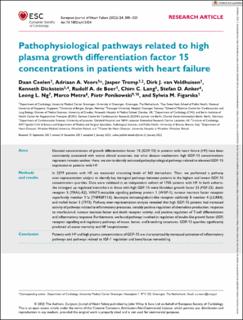| dc.contributor.author | Ceelen, Daan | |
| dc.contributor.author | Voors, Adriaan A. | |
| dc.contributor.author | Tromp, Jasper | |
| dc.contributor.author | van Veldhuisen, Dirk J. | |
| dc.contributor.author | Dickstein, Kenneth | |
| dc.contributor.author | de Boer, Rudolf A. | |
| dc.contributor.author | Lang, Chim C. | |
| dc.contributor.author | Anker, Stefan D. | |
| dc.contributor.author | Ng, Leong L. | |
| dc.contributor.author | Metra, Marco | |
| dc.contributor.author | Ponikowski, Piotr | |
| dc.contributor.author | Figarska, Sylwia M. | |
| dc.date.accessioned | 2023-03-01T12:36:21Z | |
| dc.date.available | 2023-03-01T12:36:21Z | |
| dc.date.created | 2022-05-12T13:11:26Z | |
| dc.date.issued | 2022 | |
| dc.identifier.issn | 1388-9842 | |
| dc.identifier.uri | https://hdl.handle.net/11250/3054992 | |
| dc.description.abstract | Aims
Elevated concentrations of growth differentiation factor 15 (GDF-15) in patients with heart failure (HF) have been consistently associated with worse clinical outcomes, but what disease mechanisms high GDF-15 concentrations represent remains unclear. Here, we aim to identify activated pathophysiological pathways related to elevated GDF-15 expression in patients with HF.
Methods and results
In 2279 patients with HF, we measured circulating levels of 363 biomarkers. Then, we performed a pathway over-representation analysis to identify key biological pathways between patients in the highest and lowest GDF-15 concentration quartiles. Data were validated in an independent cohort of 1705 patients with HF. In both cohorts, the strongest up-regulated biomarkers in those with high GDF-15 were fibroblast growth factor 23 (FGF-23), death receptor 5 (TRAIL-R2), WNT1-inducible signalling pathway protein 1 (WISP-1), tumour necrosis factor receptor superfamily member 11a (TNFRSF11A), leucocyte immunoglobulin-like receptor subfamily B member 4 (LILRB4), and trefoil factor 3 (TFF3). Pathway over-representation analysis revealed that high GDF-15 patients had increased activity of pathways related to inflammatory processes, notably positive regulation of chemokine production; response to interleukin-6; tumour necrosis factor and death receptor activity; and positive regulation of T-cell differentiation and inflammatory response. Furthermore, we found pathways involved in regulation of insulin-like growth factor (IGF) receptor signalling and regulatory pathways of tissue, bones, and branching structures. GDF-15 quartiles significantly predicted all-cause mortality and HF hospitalization.
Conclusion
Patients with HF and high plasma concentrations of GDF-15 are characterized by increased activation of inflammatory pathways and pathways related to IGF-1 regulation and bone/tissue remodelling. | en_US |
| dc.language.iso | eng | en_US |
| dc.publisher | Wiley | en_US |
| dc.rights | Navngivelse-Ikkekommersiell 4.0 Internasjonal | * |
| dc.rights.uri | http://creativecommons.org/licenses/by-nc/4.0/deed.no | * |
| dc.title | Pathophysiological pathways related to high plasma growth differentiation factor 15 concentrations in patients with heart failure | en_US |
| dc.type | Journal article | en_US |
| dc.type | Peer reviewed | en_US |
| dc.description.version | publishedVersion | en_US |
| dc.rights.holder | Copyright 2022 The Author(s) | en_US |
| cristin.ispublished | true | |
| cristin.fulltext | original | |
| cristin.qualitycode | 2 | |
| dc.identifier.doi | 10.1002/ejhf.2424 | |
| dc.identifier.cristin | 2023920 | |
| dc.source.journal | European Journal of Heart Failure | en_US |
| dc.source.pagenumber | 308-320 | en_US |
| dc.identifier.citation | European Journal of Heart Failure. 2022, 24 (2), 308-320. | en_US |
| dc.source.volume | 24 | en_US |
| dc.source.issue | 2 | en_US |

